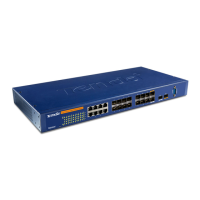24-Port Managed Gigabit Switch
3.6 Spanning Tree Configuration
3.6.1 STP Introduction
Spanning Tree Protocol is a link management protocol that provides
path redundancy while preventing undesirable loops in the network.
TEG3224T supports two versions of the Spanning Tree Protocol:
802.1d STP and 802.1w Rapid STP.
3.6.2 802.1d STP
1. Bridge Protocol Data Units
The main function of the Spanning Tree Protocol (STP) defined by
IEEE 802.1d standard is to remove layer-2 loops from your topology.
For STP to function, the switch will send bridge protocol data units
(BPDUs) as multicast information every two seconds that only other
layer-2 devices are listening to. Switches will use BPDUs to learn
the topology of the network. The BPDU contains the switch’s ID
made up of a priority value and a MAC address.
2. Root Bridge
Actually, the very first step in STP is to elect the root switch. As was
mentioned earlier, when a device advertises a BPDU, it puts its
switch ID in the BPDU to elect the root switch. The switch with the
lowest switch ID is chosen as root. The switch ID is made up of two
components: the switch’s prority (32768 by default) and the switch’s
MAC address. Through the sharing of the BPDUs, the switches will
figure out which swich has the lowest switch ID, and that switch is
30

